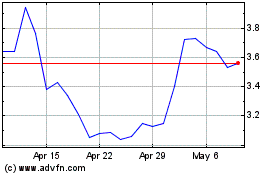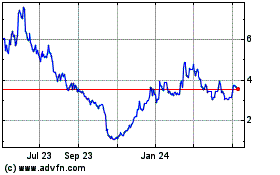-- Small-Molecule Inhibitors Enhance Immune
System and May Offer Advantages over Existing Cancer Therapies
--
Omeros Corporation (NASDAQ: OMER) today announced that its
small-molecule inhibitors against GPR174, an orphan G
protein-coupled receptor (GPCR) narrowly expressed in immune cells
and linked to cancers, substantially and statistically
significantly boost levels of cytokines and reduce the population
of a subset of T cells known as regulatory T cells (Tregs), both
activities known to be important in cancer immunotherapy. Based on
these findings, the compounds being advanced by Omeros hold
potential advantages over both chimeric antigen receptor (CAR)
T-cell therapy and checkpoint inhibitors, each highly touted
immunotherapies in development for the treatment of multiple
cancers. Part of its orphan GPCR program, Omeros believes that the
company alone has identified compounds that inhibit GPR174, and
Omeros is establishing a broad patent position directed to any
GPR174 inhibitor for the treatment of cancer.
In assays with human peripheral blood mononuclear cells (PBMCs)
evaluating T-cell proliferation and survival following T-cell
stimulation, Omeros discovered that small-molecule GPR174
inhibitors increase, with statistical significance, the levels of
cytokines interleukin 2 (IL-2) and interferon gamma (IFN-γ)
multiple-fold and nearly doubled interleukin 10 (IL-10). Moreover,
GPR174 inhibition statistically significantly reduced by
approximately 40 percent the population of Tregs, a subset of
T-cells elevated in a large number of cancers. Data from GPR174
inhibition in mouse PBMCs are consistent with the human PBMC
findings. Importantly, the compound effects were not observed in
PBMCs derived from mice genetically lacking GPR174, indicating that
the robust Omeros compound effects are the result of “on-target”
interaction with the orphan receptor.
These results demonstrate that GPR174 inhibition potentiates the
activity of effector T cells, which produce cytokines and are known
to be integral to combatting cancer. Also, reducing the level of
Tregs is a key objective in cancer immunotherapy, and high levels
of Tregs in solid tumors frequently correlates with poor patient
outcomes. In addition, signaling and mechanistic studies support
that GPR174 suppresses anti-tumor activity, and inhibitors of
GPR174 are expected to counteract that detrimental suppression.
“The data from Omeros’ GPR174 program are exciting, as they may
lead to a new approach to increase immune function through
simultaneous modulation of multiple immune cell subsets,” stated
Marc Gavin, Ph.D., Research Associate Member, Benaroya Research
Institute. “GPR174 inhibition represents a wholly new mechanism in
cancer immunotherapy, one that may offer the combined effects of
cytokine stimulation and Treg reduction across a wide variety of
cancers. This unique mechanism together with Omeros’ development of
small-molecule inhibitors targeting GPR174 could provide meaningful
benefits over other cancer immunotherapies and a significant
advance for patients.”
Based on the collective data, small-molecule inhibitors of
GPR174 could provide a significant advance in cancer immunotherapy
with meaningful potential advantages over current cancer
immunotherapies in development, including CAR-T cell therapy and
checkpoint inhibitors. Small molecules, unlike antibodies, can be
formulated for oral, intravenous, intralesional and topical
delivery, addressing some of the administration and procedural
limitations of other immunotherapies. Small-molecule compounds,
because of their shorter half-life than antibodies, should not have
the same safety concerns (e.g., acute, life-threatening immune
reactions due to extended duration of drug activity) associated
with CAR-T cell and checkpoint therapies. GPR174 inhibitors act on
both CD4 (helper) and CD8 (cytotoxic) T-cells and should not rely
on the presence of specific tumor cell-surface receptors to be
effective as do checkpoint inhibitors. GPR174 inhibitors represent
a class of agents that could treat a broad range of cancers – the
primary mechanistic limitation of a GPR174 inhibitor is expected to
be a cancer cell that is recognized by the body’s immune system as
fully “self,” i.e., a cancer cell without mutation, which is quite
rare.
“Omeros’ proprietary orphan GPCR program continues to generate
new drug targets, and GPR174 is one of our current areas of focus,”
stated Gregory A. Demopulos, M.D., chairman and chief executive
officer of Omeros Corporation. “The company’s development of GPR174
inhibitors and related target-based intellectual property position
expands our therapeutic assets to oncology and, specifically, to
the rapidly progressing and high-interest field of cancer
immunotherapy.”
About Omeros’ GPCR Program
Omeros uses its proprietary high-throughput CRA to identify
small-molecule agonists and antagonists for orphan GPCRs, or GPCRs
without known functionally active compounds (i.e., ligands),
unlocking them to drug development. Omeros believes that it is the
first to possess the capability to unlock orphan GPCRs in
high-throughput, and that currently there is no other comparable
technology. Omeros has screened a large number of orphan GPCRs
against its small-molecule chemical libraries using its
proprietary, high-throughput CRA technology. The CRA detects
receptor antagonists, agonists and inverse agonists. Omeros has
identified and confirmed sets of compounds that interact
selectively with 54 of the 81 Class A orphan receptors linked to
metabolic, cardiovascular and immunologic disorders, oncology, and
disorders of the central nervous system. Omeros has also
demonstrated that the CRA is effective in identifying ligands for
Class B GPCRs.
GPCRs, which mediate key physiological processes in the body,
are one of the most valuable families of drug targets. According to
Insight Pharma Reports, GPCR-targeting drugs represent 30 to 40
percent of marketed pharmaceuticals. Examples include Claritin®
(allergy), Zantac® (ulcers and reflux), OxyContin® (pain),
Lopressor® (high blood pressure), Imitrex® (migraine headache),
Reglan® (nausea) and Abilify® (schizophrenia, bipolar disease and
depression) as well as all other antihistamines, opioids, alpha and
beta blockers, and compounds acting through serotonin and dopamine
receptors.
The industry focuses its GPCR drug discovery efforts mostly on
non-sensory GPCRs. Of the 363 total non-sensory GPCRs,
approximately 240 have known ligands with nearly half of those
targeted either by marketed drugs (46 GPCRs) or by drugs in
development (about 82 GPCRs). There are approximately 120 orphan
GPCRs, which have no known ligands. Without a known ligand, drug
development for a given receptor is extremely difficult.
About Omeros Corporation
Omeros is a biopharmaceutical company committed to discovering,
developing and commercializing both small-molecule and protein
therapeutics for large-market as well as orphan indications
targeting inflammation, coagulopathies and disorders of the central
nervous system. Part of its proprietary PharmacoSurgery® platform,
the company’s first drug product, OMIDRIA® (phenylephrine and
ketorolac injection) 1% / 0.3%, was broadly launched in the U.S. in
April 2015. OMIDRIA is the first and only FDA-approved drug (1) for
use during cataract surgery or intraocular lens (IOL) replacement
to maintain pupil size by preventing intraoperative miosis (pupil
constriction) and to reduce postoperative ocular pain and (2) that
contains an NSAID for intraocular use. In the European Union, the
European Commission has approved OMIDRIA for use in cataract
surgery and lens replacement procedures to maintain mydriasis
(pupil dilation), prevent miosis (pupil constriction), and to
reduce postoperative eye pain. Omeros has clinical-stage
development programs focused on: complement-associated thrombotic
microangiopathies; complement-mediated glomerulonephropathies;
Huntington’s disease and cognitive impairment; and addictive and
compulsive disorders. In addition, Omeros has a proprietary G
protein-coupled receptor (GPCR) platform, which is making available
an unprecedented number of new GPCR drug targets and corresponding
compounds to the pharmaceutical industry for drug development, and
a platform used to generate antibodies.
Forward-Looking Statements
This press release contains forward-looking statements within
the meaning of Section 27A of the Securities Act of 1933 and
Section 21E of the Securities Exchange Act of 1934, which are
subject to the “safe harbor” created by those sections for such
statements. All statements other than statements of historical fact
are forward-looking statements, which are often indicated by terms
such as “anticipate,” “believe,” “could,” “estimate,” “expect,”
“goal,” “intend,” “look forward to,” “may,” “plan,” “potential,”
“predict,” “project,” “should,” “will,” “would” and similar
expressions and variations thereof. Forward-looking statements are
based on management’s beliefs and assumptions and on information
available to management only as of the date of this press release.
Omeros’ actual results could differ materially from those
anticipated in these forward-looking statements for many reasons,
including, without limitation, risks associated with product
commercialization and commercial operations, unproven preclinical
and clinical development activities, regulatory oversight,
intellectual property claims, competitive developments, litigation,
and the risks, uncertainties and other factors described under the
heading “Risk Factors” in the company’s Quarterly Report on Form
10-Q filed with the Securities and Exchange Commission on November
9, 2016. Given these risks, uncertainties and other factors, you
should not place undue reliance on these forward-looking
statements, and the company assumes no obligation to update these
forward-looking statements, even if new information becomes
available in the future.
View source
version on businesswire.com: http://www.businesswire.com/news/home/20161205005499/en/
Cook Williams Communications, Inc.Jennifer Cook WilliamsInvestor
and Media Relations360-668-3701jennifer@cwcomm.org
Omeros (NASDAQ:OMER)
Historical Stock Chart
From Mar 2024 to Apr 2024

Omeros (NASDAQ:OMER)
Historical Stock Chart
From Apr 2023 to Apr 2024
